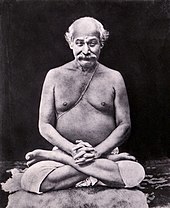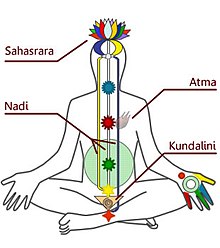|
Kriya Yoga school
Kriya Yoga (Sanskrit: क्रिया योग) is a yoga system which consists of a number of levels of pranayama, mantra, and mudra, intended to rapidly accelerate spiritual development[2] and engender a profound state of tranquility and God-communion.[3] It is described by its practitioners as an ancient yoga system revived in modern times by Lahiri Mahasaya, who claimed to be initiated by a guru, Mahavatar Babaji, circa 1861 in the Himalayas. Kriya Yoga was brought to international awareness by Paramahansa Yogananda's book Autobiography of a Yogi and through Yogananda's introductions of the practice to the West from 1920. EtymologyAccording to Yogananda, "Kriya is an ancient science. Lahiri Mahasaya received it from his great guru, Babaji, who rediscovered and clarified the technique after it had been lost in the Dark Ages. Babaji renamed it, simply, Kriya Yoga."[4] In his commentary on the Bhagavad Gita, Yogananda further explains that
Jaerschky elucidates that kabali (Bengali) is synonymous with kaivalya (kevali, kevala),[6] "isolation," the isolation of purusha (consciousness, spirit) from prakriti (nature or matter, including the human mind and emotions), or the unification with God. According to Jaerschky, kevali-pranayama leads to kevala kumbhaka, "the natural state of breathlessness, which is the goal of all deep yogis."[5] YogaThe Sanskrit noun योग yoga is derived from the root yuj (युज्) "to attach, join, harness, yoke"[7] (yoga is a cognate of the English word "yoke"[8]). According to Timothy Miller, the term yoga may designate various spiritual practices in Hindu traditions, translating it as "union" or "discipline".[2] In the context of the Yoga Sutras, to which reference is often made to explain the name Kriya Yoga, the root yuj samādhau (to concentrate) is considered the correct etymology by traditional commentators.[9][note 1] KriyaA kriya may refer to any kind of practice in the context of yoga, and teachers of psychophysical practices often use the term. Philip Goldberg writes that, as a brand, Kriya Yoga generally refers to the lineage that Yogananda represented. He also cites the following definition found in Yogananda's autobiography.[12] According to Yogananda,
According to Jones and Ryan, kriya Yoga may be literally translated as "yoga of ritual action," noting that it "is contrasted with jnana (learning) yoga and equated with karma (action) yoga in the Trishikhi-Brahmana Upanishad."[14] The Yoga Sutras of Patanjali 2.1 defines three types of kriyā, namely tapas ("heat," ascetic practices), svadhyaya (study or recitation of the Vedas, or “contemplation, meditation, reflection of one's self”), and Isvara pranidhana (devotion or surrender to God).[note 2] In the Kriya Yoga school, 'ritual action' involves breathing techniques (pranayama) revolving the life energy (prana) "upward and downward, around the six spinal centers"[4] and upwards to the crown-chakra.[14] Kriya yoga as inner fire ritualTanya Lynne Brittain further explains that while "Kriya yoga is 'usually understood to mean 'yoga as practice' or “practical yoga,' [...][it is] also associated with the vocabulary of initiation and sacrifice." The kriya yoga pranayama practices are a form of kundalini-practice, which culminate in kriya, the "inner fire rite," the internalized Vedic fire sacrifice.[16] Yael Bentor further explains that in the Upanishads this internalized fire ritual is associated with the maintenance of life, through breathing and eating. Where the Brahmin maintains the world order by his sacrifices, for the yogi the breath becomes a perpetual ritual. The internalization of the fire is also associated with tapas, "heat," burning away the defilements, and with pranayama, the control of the breath. These concepts were combined in the yoga of the subtle body.[17] Yogananda writes:[18]
History The origins of the present-day forms of Kriya Yoga can be traced back to Lahiri Mahasaya, who said he received initiation into the yoga techniques from an immortal Himalayan yogi called Mahavatar Babaji.[19][20] The story of Lahiri Mahasaya receiving initiation into Kriya Yoga by Mahavatar Babaji in 1861 is recounted in Autobiography of a Yogi.[21][22] Yogananda wrote that at that meeting, Mahavatar Babaji told Lahiri Mahasaya, "The Kriya Yoga that I am giving to the world through you in this nineteenth century, is a revival of the same science that Krishna gave millenniums ago to Arjuna; and was later known to Patanjali, and Christ, and to St. John, St. Paul, and other disciples."[3] Yogananda also wrote in God Talks With Arjuna: The Bhagavad Gita that the science of Kriya Yoga was given to Manu, the original Adam, and through him to Janaka and other royal sages.[23][24] Through Lahiri Mahasaya, Kriya Yoga soon spread throughout India.[3] Lahiri Mahasaya's disciples included his two sons (Dukouri Lahiri and Tinkouri Lahiri), Sri Yukteswar Giri, Panchanan Bhattacharya, Swami Pranabananda, Swami Kebalananda, Keshavananda Brahmachari, Bhupendranath Sanyal (Sanyal Mahasaya), and many others.[25] Kriya Yoga was brought to international awareness by Paramahansa Yogananda, a disciple of Swami Sri Yukteswar Giri, with his book Autobiography of a Yogi[2][3] and through Yogananda's introductions of the practice to the West from 1920.[26][27][28] Practice  Kriya Yoga, as taught by Lahiri Mahasaya, is traditionally learned exclusively via the Guru-disciple relationship, and the initiation consists of a secret ceremony.[29][2] He recounted that after his initiation into Kriya Yoga, "Babaji instructed me in the ancient rigid rules which govern the transmission of the yogic art from Guru to disciple."[30] Yogananda's Autobiography of a Yogi mentions the practice of Kriya Yoga, but it doesn't provide details about how to practice specific techniques. Rizwan Virk writes that "The purpose of the book was to inspire readers to take up the yogic path by opening their minds to spiritual possibilities."[31] In Yogananda's 6 October 1920 speech at the International Congress of Religious Liberals in Boston, he said that the Kriya Yoga of his lineage "consists of magnetizing the spinal column and the brain, which contain the seven main centers, with the result that the distributed life electricity is drawn back to the original centers", thus liberating the "spiritual Self" from physical and mental distractions. Yogananda used the word centers in place of the term chakras. Philip Goldberg writes that Yogananda described Kriya Yoga in essentially the same way in Autobiography of a Yogi.[32] Yogananda wrote:[3]
The practice of Kriya Yoga involves specific breathing patterns.[14] Yogananda claims that the process of performing Kriya Yoga leads to a certain purification of the blood which frees up the life force to withdraw into the spine:[33]
Satyananda Giri writes that "Kriya sadhana may be thought of as the sadhana of the 'practice of being in Atman'".[34] There are many higher kriyas in the kriya yoga tradition. According to the Autobiography of a Yogi, Lahiri Mahasaya divided Kriya Yoga into four parts. The second, third and the fourth Kriya are known as higher Kriyas, Thokar Kriya being one of them.[3][34] Sources and inspirationsAccording to Yogananda, the elusive Mahavatar Babaji introduced the concept of Kriya Yoga pranayama as essentially identical to the Raja Yoga of Patanjali and the concept of Yoga as described in the Bhagavad Gita.[3] According to Yogananda, Kriya Yoga was well known in ancient India, but was eventually lost, due to "priestly secrecy and man’s indifference".[3] A direct disciple of Sri Yukteswar Giri, Sailendra Dasgupta (d. 1984) has written that, "Kriya entails several acts that have evidently been adapted from the Gita, the Yoga Sutras, Tantra shastras and from conceptions on the Yugas."[29] Bhagavad GitaThe Bhagavad Gita does not teach Kriya Yoga pranayama by name, but Yogananda claimed that the fundamental idea of the practice – control over the mind and the body's energy (prana) – is expressed therein. In his commentary on the Gita, God Talks with Arjuna, Yogananda asserts that Krishna reveals the "safe path" of Kriya Yoga to the disciple Arjuna in the Gita. Specifically, Yogananda claims that verses IV:29 and V:27–28 about breath control and meditation describe the essential concepts of Kriya Yoga.[35] According to Yogananda's commentary, Krishna describes Kriya Yoga thusly:
Yogananda also stated that Krishna was referring to Kriya Yoga pranayama when "Krishna ... relates that it was he, in a former incarnation, who communicated the indestructible yoga to an ancient illuminato, Vivasvat, who gave it to Manu, the great legislator. He, in turn, instructed Ikshwaku, the father of India’s solar warrior dynasty."[3] Yoga Sutras of Patanjali According to Yogananda, "Kriya Yoga is mentioned twice by the ancient sage Patanjali, foremost exponent of yoga, who wrote: 'Kriya Yoga consists of body discipline, mental control, and meditating on Aum.'—Yoga Sutras II:1."[4] The Yoga Sutras of Patanjali 2.1 actually uses the term kriya yoga when describing a "yoga of action (kriyayoga)," defining three types of kriya (action):
According to George Feuerstein, this kriya yoga is contained in chapter 1, chapter 2 verse 1-27, chapter 3 except verse 54, and chapter 4.[37] The "eight limb yoga" is described in chapter 2 verse 28–55, and chapter 3 verse 3 and 54.[37][note 3] According to Barbara Miller, Kriya yoga as described in the Yoga Sutras is the "active performance of yoga."[41] It is part of the niyamas, "observances", the second limb of Patanjali's eight limbs.[41][note 4] Yogananda stated that Patanjali wrote a second time about the Kriya Yoga pranayama technique when he wrote: "Liberation can be attained by that pranayama which is accomplished by disjoining the course of inspiration and expiration" (YS 2.49).[3][4] Guru–shishya parampara of Kriya YogaThe lineage of Self-Realization Fellowship (SRF)/Yogoda Satsanga Society of India (YSS), founded by Paramahansa Yogananda includes Bhagavan Krishna, Jesus Christ, Mahavatar Babaji, Lahiri Mahasaya, Sri Yukteswar Giri and Paramahansa Yogananda. According to SRF, Yogananda stated, before his passing, that it was "God's wish that he be the last in the SRF line of Gurus."[43] Yogananda said that his writings, especially those compiled in SRF's home-study course (the SRF Lessons), would facilitate the spiritual instruction of disciples after his death.[44] When questioned about the succession of SRF/YSS leadership, Yogananda answered, “There will always be at the head of this organization men and women of realization. They are already known to God and the Gurus. They shall serve as my spiritual successor and representative in all spiritual and organizational matters.”[45] According to the Kriya Yoga Institute, their lineage includes Mahavatar Babaji, Lahiri Mahasaya, Sri Yukteswar Giri, Shrimat Bhupendranath Sanyal Mahashaya, Paramahansa Yogananda, Satyananda Giri, and Hariharananda Giri.[46] Hariharananda Giri was a disciple of Sri Yukteswar Giri and managed one of Yogananda's ashrams in India until 1959. He began visiting the United States in 1975 and established the Kriya Yoga Institute in Homestead, Florida.[47] See alsoNotes
References
Sources
Further reading
External linksWikisource has original text related to this article:
|
||||||||
